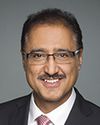Minister, thank you for being here once again. I'd like to reiterate my thanks from the last time. In Mississauga, your signing of the bilateral agreement and the announcement of $339 million will go very far in helping our public transit. I wanted to thank you again for that announcement.
In that vein, Minister, I was wondering if you could give us a general update on where things stand with the infrastructure program at this point. We're essentially halfway through the term when you think about budget cycles, as you recently said. How do you feel things are going given that we now have two budgets behind us?






